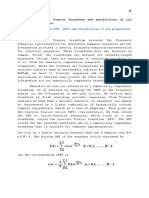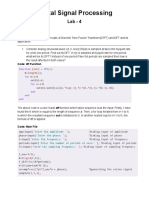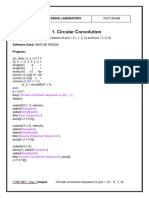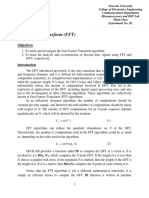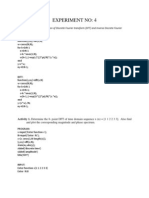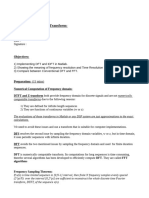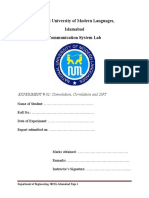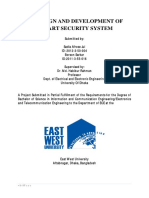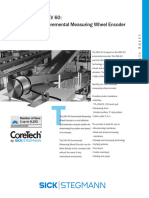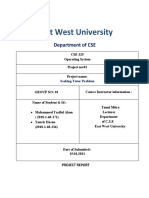Digital Signal Processing
Lab 3: Discrete Fourier Transform
Discrete Time Fourier Transform (DTFT)
The discrete-time Fourier transform (DTFT) of a sequence x[n] is given by
𝑋(𝑒 𝑗𝜔 ) = ∑∞
𝑛=−∞ 𝑥[𝑛] 𝑒
−𝑗𝜔𝑛
(3.1)
which is a continuous function of ω, with period 2π.
The inverse discrete-time Fourier transform (IDTFT) of X(ejω) is given by
1 𝜋
𝑥[𝑛] = 2𝜋 ∫−𝜋 𝑋(𝑒 𝑗𝜔 )𝑒 𝑗𝜔𝑛 𝑑𝜔 (3.2)
Important observation. Matlab cannot be used to perform directly a DTFT, as X(ejω) is a function of the
continuous variable ω. However, if x[n] is of finite duration, eq. (3.1) can be applied to evaluate
numerically X(ejω) at any desired frequency ω= ω0.
Given a real-valued sequence x[n], considering the periodicity and the symmetries of its discrete-time
Fourier transform, to represent graphically X(ejω) we need to consider only a half period of X(ejω).
Generally, in practice ω is chosen to be in the interval [0, π].
If x[n] is of infinite duration, then eq. (3.1) cannot be used to evaluate X(ejω) from x[n] with Matlab.
However, we can derive the analytic expression of X(ejω) and then plot its magnitude and angle (or real
and imaginary parts) over a set of frequencies in [0, π].
Example 1: Determine the frequency response H(ejω) of a system characterized by the impulse response
h[n] = (0.9)n u[n]. Plot the magnitude and the phase responses.
∞ ∞
1
𝐻(𝑒 𝑗𝜔 ) = ∑ ℎ(𝑛)𝑒 −𝑗𝜔𝑛 = ∑(0.9)𝑛 𝑒 −𝑗𝜔𝑛 =
1 − 0.9𝑒 −𝑗𝜔
−∞ 0
We evaluate H(ejω) on 501 points uniformly distributed in the range [0, π]
w = [0:1:500]*pi/500; % 501 points on the [0, pi] axis
H = 1 ./ (1 - 0.9*exp(-j*w));
magH = abs(H); angH = angle(H);
subplot(2,1,1); plot(w/pi,magH); grid;
xlabel('\omega/\pi'); ylabel('|H|');
title('Magnitude Response');
1
�subplot(2,1,2); plot(w/pi,angH/pi); grid
xlabel('\omega/\pi'); ylabel('Phase in radians/\pi');
title('Phase Response');
Discrete Fourier Transform (DFT)
The Discrete Fourier Transform of an N -point sequence x[n] is given by
𝑁−1
𝑋[𝑘] = ∑ 𝑥[𝑛]𝑊𝑁𝑘𝑛 0≤ 𝑘 ≤ 𝑁−1 (3.3)
𝑛=0
2𝜋
where 𝑊𝑁 = 𝑒 −𝑗 𝑁
The Inverse Discrete Fourier Transform of an N -point DFT X[k] is given by
𝑁−1
1
𝑥[𝑛] = ∑ 𝑋[𝑘]𝑊𝑁−𝑘𝑛 0≤𝑛≤𝑁−1 (3.4)
𝑁
𝑘=0
If x[n] and X[k] are arranged as column vectors x and X we can write the DFT and IDFT as the matrix
products X=MNx and x=M-1N X where we have used the square MN matrix defined as
Note that this matrix can be generated directly in Matlab by the function dftmtx(N).
A direct way to implement the computation of the matrix MN is the following:
n = [0:1:N-1];
k = [0:1:N-1];
MN = exp(-j*2*pi/N *n'*k); % MN is a N by N DFT matrix
The following functions are a direct implementation of DFT and inverse DFT according to equations (3.3)
and (3.4). They are inefficient for large values of N.
2
�function [Xk] = dft(xn,N)
% Computes Discrete Fourier Transform
% -----------------------------------
% [Xk] = dft(xn,N)
% Xk = DFT coeff. array over 0 <= k <= N-1
% xn = N-point finite-duration sequence
% N = Length of DFT
%
n = [0:1:N-1];
k = [0:1:N-1];
xn=xn(:); % make sure xn is a column vector
WN = exp(-j*2*pi/N *n'*k); % creates a N by N DFT matrix
Xk = WN * xn;
Xk=Xk.'; % make it a row vector of DFT coefficients
function [xn] = idft(Xk,N)
% Computes Inverse Discrete Fourier Transform
% -----------------------------------
% [xn] = idft(Xk,N)
% xn = N-point sequence over 0 <= n <= N-1
% Xk = DFT coeff. array over 0 <= k <= N-1
% N = length of DFT
%
n = [0:1:N-1];
k = [0:1:N-1];
Xk=Xk(:); % make sure Xk is a column vector
WN = exp(j*2*pi/N *n'*k); % creates a N by N IDFT matrix
xn = (WN * Xk)/N;
xn = xn.'; % make it a row vector
Warning: if c is a complex vector, the vector c' is its transpose-conjugate. If you just want to transform
from row to column (or vice versa) use the operation c.'
3
�Example 2. Given the sequence x[n] equal to 1 for 0 ≤ n <N and equal to 0 elsewhere, compute its DFT
on N points and compare the magnitude of its DFT coefficients with the magnitude of its DTFT.
The DTFT is given by
𝑁−1
𝑗𝜔
1 − 𝑒 −𝑗𝜔𝑁 𝑠𝑖𝑛(𝜔𝑁/2) 𝑗(𝑁−1)𝜔/2
𝑋(𝑒 ) = ∑ 𝑥[𝑛]𝑒 −𝑗𝜔𝑛 = = 𝑒
1 − 𝑒 −𝑗𝜔 𝑠𝑖𝑛(𝜔/2)
0
𝑗𝜔 𝑠𝑖𝑛(𝜔𝑁/2)
and its magnitude is |𝑋(𝑒 )| = | 𝑠𝑖𝑛(𝜔/2) |
N=11;
w=0:1/1000:2*pi;
magX=abs(sin(N*w/2)./sin(w/2));
plot(w/pi,magX); grid
x=ones(1,N);
X=dft(x,N);
hold on;
stem(2*[0:N-1]/N,abs(X),'r'); % N equispaced samples in [0:2π]
What happens if the sequences x[n] is padded with N zeros?
x2=[ones(1,N) zeros(1,N)];
X2=dft(x2,2*N);
stem(2*[0:2*N-1]/(2*N),abs(X2),'g'); % 2*N equispaced samples
And what happens when the sequences x[n] is padded with a multiple of N zeros?
x6=[ones(1,N) zeros(1,5*N)];
X6=dft(x6,6*N);
stem(2*[0:6*N-1]/(6*N),abs(X6),'m'); % 6*N equispaced samples
hold off
4
�Circular shift of a sequence
The following function implements the circular shift of m samples of a sequence x[n] with respect to a
buffer of length N. The length of the sequence x[n] must be ≤N.
Note that the modulo-N operation is being used on the argument (n−m) to implement this operation.
function y = cirshftt(x,m,N)
% Circular shift of m samples wrt size N
% in sequence x
% -----------------------------------------------------------
% [y] = cirshftt(x,m,N)
% y = output sequence containing the circular shift
% x = input sequence of length <= N
% m = shift in samples
% N = size of circular buffer
if length(x) > N
error('N must be >= length of x')
end
x = [x zeros(1,N-length(x))];
nx = [0:N-1];
ny = mod(nx-m,N); % apply shift to sample indexes
y = x(ny+1); % indexes of Matlab vectors must start from 1
Circular convolution
When we multiply two N-point DFTs in the frequency domain, we get correspondingly the circular
convolution (and not the usual linear convolution) of the original sequences in the time domain.
𝑁−1
𝑥3 [𝑛] = ∑ 𝑥1 [𝑚] 𝑥2 [〈𝑛 − 𝑚〉𝑁 ] ↔ 𝑋3 [𝑘] = 𝑋1 [𝑘] ⋅ 𝑋2 [𝑘]
𝑚=0
The following function implements the circular convolution of two sequences directly in the time-domain.
function y = circonvt(x1,x2,N)
% N-point circular convolution between x1 and x2: (time-domain)
% -------------------------------------------------------------
% [y] = circonvt(x1,x2,N)
% y = output sequence containing the circular convolution
% x1 = input sequence of length N1 <= N
% x2 = input sequence of length N2 <= N
% N = size of circular buffer
% Method: y(n) = sum (x1(m)*x2((n-m) mod N))
if length(x1) > N
5
�error('N must be >= the length of x1')
end
if length(x2) > N
error('N must be >= the length of x2')
end
x1=[x1 zeros(1,N-length(x1))];
x2=[x2 zeros(1,N-length(x2))];
m = [0:1:N-1];
x2n = x2(mod(-m,N)+1); % obtain the sequence x2n[n]=x2[-n]
for n = 0:N-1
y(n+1)=x1 * cirshftt(x2n,n,N).';
end
Important observation: Given the sequences x1[n] of length N1 and x2[n] of length N2, if we make both
x1[n] and x2[n] sequences of length N=N1+N2−1 by padding an appropriate number of zeros, then the
circular convolution is identical to the linear convolution.
Example 3:
>> conv([1 2 3], [-1 1 1 -1])
ans = -1 -1 0 4 1 -3
>> circonvt([1 2 3], [-1 1 1 -1],6)
ans = -1 -1 0 4 1 -3
Exercise. Verify that in the previous example N=6 is the minimum length of the circular convolution in
order to obtain the same result as the linear convolution. What happens when we choose N>6?
Note that Matlab provides a specific function circshift to shift array circularly and the function
cconv to perform modulo-N circular convolution. Moreover, the implementations of DFT presented
above have only didactical purpose. Matlab offers much more efficient functions to compute DFT.
Example 4:
a = [1 2 -1 1];
b = [1 1 2 1 2 2 1 1];
c = cconv(a,b); % Circular convolution
cref = conv(a,b); % Linear convolution
6
�Fast Fourier Transform (FFT)
Matlab provides an efficient fft function to compute the DFT of a vector x. It is invoked by
X = fft(x,N)
which computes the N-point DFT. If the length of x is less than N, then x is padded with zeros. If the
argument N is omitted, then the length of the DFT is the length of x. If x is a matrix, then fft(x,N)
computes the N-point DFT of each column of x.
The implementation is very efficient as it is written in machine language (i.e., it is not available as a .m
file) and therefore it executes very fast.
If N is a power of two, then a high-speed radix-2 FFT algorithm is employed. If N is not a power of two,
then N is decomposed into prime factors and a slower mixed-radix FFT algorithm is used. Finally, if N is
a prime number, then the fft function is reduced to the raw DFT algorithm.
The inverse DFT is computed using the ifft function, which has the same characteristics as fft.
Note that fft(x) assumes that the first sample of x is at time instant n=0.
Exercise. Compare the results of Example 2, where the function dft was used, with those produced
when using the function fft.
Example 5. Plot magnitude, phase, real part and imaginary part of the 512-points FFT of the sequence
x[n] = (-0.9)n , −10 ≤ n ≤ 10.
As the sequence is real, it is enough to limit the plot in the frequency interval [0, π].
nx=[-10:10];
x=(-0.9).^nx;
M=512; %length of the fft to have a good frequency resolution
% fft assumes that the first sample of x is at time instant 0
% therefore we need a suitable circular shift
x=cirshftt(x,-10,M);
X=fft(x,M);
X=X(1:M/2); % take only the interval between 0 and pi
w=[0:(M/2-1)]/(M/2);
magX = abs(X); angX = angle(X);
realX = real(X); imagX = imag(X);
subplot(2,2,1); plot(w,magX); grid
7
�xlabel('\omega/\pi'); title('Magnitude of X');
subplot(2,2,2); plot(w,angX/pi); grid
xlabel('\omega/\pi'); ylabel('Phase of in radians/\pi');
title('Phase of X')
subplot(2,2,3); plot(w,realX); grid
xlabel('\omega/\pi'); title('Real Part of X');
subplot(2,2,4); plot(w,imagX); grid
xlabel('\omega/\pi'); title('Imaginary Part of X');
Example 6. Compute the DFT of the sequence x[n] = {1, 2, 3, 4, 5} on 512 points and plot magnitude,
phase, real part and imaginary part.
n = -1:3; x = 1:5;
M=512;
x=cirshftt(x,-1,M);
X=fft(x,M);
k = 0:M-1;
w = (2*pi/M)*k; % frequency values between 0 and 2*pi
magX = abs(X); angX = angle(X);
realX = real(X); imagX = imag(X);
subplot(2,2,1); plot(w/pi,magX); grid
xlabel('\omega/\pi'); title('Magnitude');
subplot(2,2,2); plot(w/pi,angX/pi); grid
xlabel('\omega/\pi'); ylabel('Phase in radians/\pi'); title('Phase')
subplot(2,2,3); plot(w/pi,realX); grid
xlabel('\omega/\pi'); title('Real Part');
subplot(2,2,4); plot(w/pi,imagX); grid
xlabel('\omega/\pi'); title('Imaginary Part');
Compare the obtained plots with the graphical representation in the complex plane produced by
figure; polar(angX,magX,'-o')
Exercise: Repeat the same analysis for the sequences x1[n] = {1, 1, 1, 1, 1} and x2[n] = {1, 1, 1, 1, 1}.
Compare and comment on the results.
Hint: in the case of x2[n], something strange seems to happen: the non-infinite precision of computations
has its relevance.
8
�Based on the properties of the DFT, a convolution can be computed as inverse FFT of the product of the
FFTs of two sequences. The following fastconv function represents an implementation of this
procedure. For efficiency, the length of the FFTs is equal to the next power of 2 with respect to the
foreseen length of the output sequence (this value can be also obtained with the Matlab function
nextpow2). For long input sequences this approach provides a faster convolution.
function [y] = fastconv(x,h)
% Fast convolution using FFT
% --------------------------------------------------------------
% [y] = fastconv(x,h)
% y = output sequence
% x = first input sequence
% h = second input sequence
%
L=length(x)+length(h)-1; % output length
N = 2^(ceil(log10(L)/log10(2))); % next power of 2
y = ifft(fft(h,N).*fft(x,N)); % zero padding up to length N
y=y(1:L);
Exercise. Compare the results of Example 3 with those produced when using the function fastconv.
Verification of some properties of the DFT
The following examples verify empirically some important properties of the DFT.
Linearity
x1 = rand(1,11); x2 = rand(1,11);
alpha = 2; beta = 3;
X1=fft(x1);
X2=fft(x2);
x = alpha*x1 + beta*x2; % Linear combination of x1 & x2
X = fft(x); % DFT of x
% verification
X_check = alpha*X1 + beta*X2; % Linear Combination of X1 & X2
error = max(abs(X-X_check)) % check entity of max error
% within the limited numerical precision of Matlab?
9
�Time-shift property
x = rand(1,11);
X=fft(x);
% signal shifted by three samples
y=cirshftt(x,3,length(x));
Y=fft(y);
k = 0:length(x)-1;
w = (2*pi/length(x))*k; % frequency values
% verification
Y_check = exp(-j*3*w).*X;
error = max(abs(Y-Y_check)) % check entity of max error
Frequency-shift property
Let us consider x[n] =0.9n, 0 ≤ n ≤ 100 and y[n] = ejπn/4 x[n]
n = 0:100; x=0.9.^n;
X=fft(x);
y = exp(j*pi*n/4).*x; % signal multiplied by exp(j*pi*n/4)
Y = fft(y);
k = 0:length(x)-1;
w = (2*pi/length(x))*k; % frequency values between 0 and 2*pi
% Graphical verification
subplot(2,2,1); plot(w/pi,abs(X)); grid; axis([0,2,0,12])
xlabel('\omega/\pi'); ylabel('|X|');
title('Magnitude of X');
subplot(2,2,2); plot(w/pi,angle(X)/pi); grid; axis([0,2,-0.5,0.5])
xlabel('\omega/\pi'); ylabel('radians/\pi');
title('Phase of X');
subplot(2,2,3); plot(w/pi,abs(Y)); grid; axis([0,2,0,12])
xlabel('\omega/\pi'); ylabel('|Y|');
title('Magnitude of Y');
subplot(2,2,4); plot(w/pi,angle(Y)/pi); grid; axis([0,2,-0.5,0.5])
xlabel('\omega/\pi'); ylabel('radians/\pi');
title('Phase of Y');
10
�Example7
A finite-length sinusoidal sequence is given by x1[n]=cos(ω0n), for 0≤n<32 and ω0=2π·5/32.
Compute the DFTs on 32, 64, 128 points and plot their magnitude. How are are the various obtained
DFTs related to the DTFT of the sequence?
N=32;
n=0:N-1;
w0=2*pi*5/N;
x1=cos(w0*n);
%x1=exp(j*w0*n);
stem(n,x1); pause
A1=abs(fft(x1,N));
stem(0:N-1,A1); pause
A2=abs(fft(x1,2*N));
stem(0:2*N-1,A2); pause
A4=abs(fft(x1,4*N));
stem(0:4*N-1,A4); pause
LN=256*N; % very large, to approximate DTFT
AA=abs(fft(x1,LN));
plot(2*(0:LN-1)/LN,AA,'r');
xlabel('\omega/\pi'); pause
hold on
stem(2*(0:N-1)/N,A1); pause
stem(2*(0:2*N-1)/(2*N),A2); pause
stem(2*(0:4*N-1)/(4*N),A4)
hold off
Repeat the analysis for ω0=2π·5.5/32 and also for x1[n]=exp(j·ω0n).
Example 9: Spectral analysis of a whale call.
The file bluewhale.wav contains audio data from a Pacific blue whale vocalization recorded by
underwater microphones off the coast of California. The file is from the library of animal vocalizations
maintained by the Cornell University Bioacoustics Research Program.
Because blue whale calls contain very low frequencies, they are barely audible to humans. Therefore the
time scale in the data has been compressed by a factor of 10 to raise the pitch (i.e. frequencies become 10
times higher) and make the call more clearly audible.
11
�[x,fs]=audioread('bluewhale.wav'); %read audio data from file
plot(x)
sound(x,fs) % listen the compressed-time signal
An A "trill" is followed by a series of three B "moans". The B call is simpler and easier to analyze. After
selecting a subsequence corresponding to the first B call it is possible to analyze its frequency content by
means of a Discrete Fourier Transform.
b= x(2.45e4:3.10e4);
B=fft(b);
f=fs/length(b)*[0:(length(b)-1)];
plot(f/10,abs(B)) % plot with the true frequency scale
The B call is composed of a fundamental frequency around 17 Hz and a sequence of harmonics, with the
second harmonic emphasized.
A more complete spectral analysis of the full sequence is obtained with a graphical representation
(spectrogram) of the so called Short Time Fourier Transform, which is obtained as a sequence of DFTs
computed on adjacent short intervals of the signal.
Try for example:
winlen=512; step=256; Nfft=1024;
spectrogram(x,winlen,step,Nfft,fs/10,'yaxis')
Exercises
1. Plot magnitude, phase, real part and imaginary part of the DFT of the following sequences
x1[n] = (0.7)|n| ·(u[n+20]-u[n-21])
x2[n]=n·(0.9)n ·(u[n]-u[n-21])
2. Given x[n]=10·(0.7)n, 0≤n≤10, determine y[n]= x[〈−𝑛〉11 ]. Compute the DFTs of x[n] and y[n]. How
are they related?
3. Using a fft-based spectral analysis determine graphically which tones are present in the sequence
generated by the Matlab instruction x=cos(pi*n/5)+sin(n); when n=[0:300], assuming a
sampling rate of 1 kHz.
12






